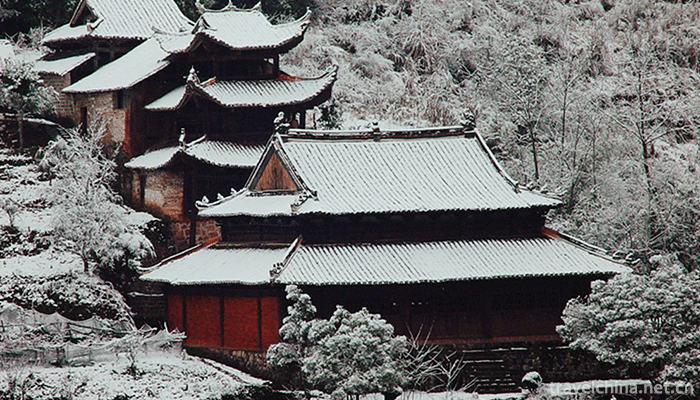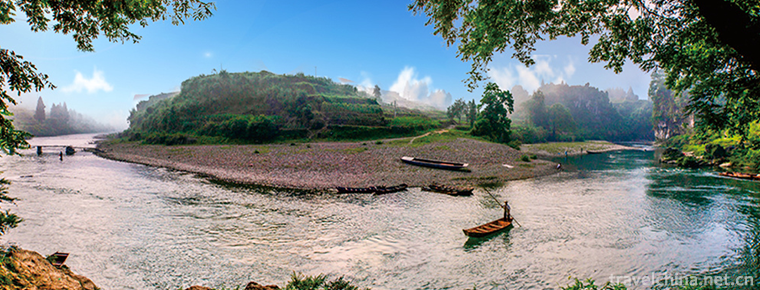Laosicheng Site
Laosicheng Site
Laosicheng Site is located in Laosicheng Village, Lingxi Town, more than 20 kilometers east of Yongshun County, Tujia and Miao Autonomous Prefecture, western Hunan Province. Fushicheng, originally named as Fushicheng, moved to Zhisha Township in 1724. In order to distinguish the old from the new, Fushicheng, also known as Laosheng, was the political, economic, military and cultural center of Peng Chieftain in Yongshun from Shaoxing in the Southern Song Dynasty (1135) to Yongzheng in the Qing Dynasty (1724).
Laoshi City is divided into Nero City and Wailuo City, with eight streets and ten lanes crisscrossing, densely populated and prosperous shops. Historical books include "3000 households in the city, 800 households outside the city", "the huge town of five streams, the border city of ten thousand miles".
Laosicheng is the materialized carrier of the Chieftain System and a living specimen of the development of the regional ethnic autonomy system in ancient China. It was announced as the fifth batch of national key cultural relics protection units in 2001. In September 2010, Laosicheng Site was listed in the list of the first national archaeological sites parks in China. On July 04, 2015, the "Chinese Chieftain Heritage" jointly represented by Laoshi City Site in Yongshun, Tangya Tusi City Site in Enshi, Hubei Province and Hailongtun Tusi Site in Zunyi, Guizhou Province was listed on the World Cultural Heritage List. On May 01, 2016, Laosicheng Site was officially opened as a scenic spot. In December 2016, Laosicheng scenic spot was listed as national AAAA-level tourist attraction.
Historical evolution
In the fourth year of Liang Kaiping (910 A.D.) after the Five Dynasties, Ma Yin, king of Southern Chu, admitted Peng Lung to Southern Chu and made Peng Lung serve as the assassin of Xizhou. Peng's kindness in Xizhou united the hearts of the people. He was welcomed by the people of Xizhou and became the hereditary chieftain of Xizhou.
In the fifth year of Shaoxing in the Southern Song Dynasty (1135), Peng Fushichong (Peng Fushichong) served as Chieftain. He often felt that Shizhi (Chieftain's Office) was bound by Chenzhou forces in Xiaxhou (Huixiping, Ancient Zhang County), so he moved Shizhi to Fushi County, Lingxi, and built a city here, that is, the Old Chicheng. There is another record about the change of Sizhi: before moving to Laoshi City, that is, in 971 A.D., the fourth Tusi Peng Yunlin moved Sizhi to Longtan City (Macha Township in Yongshun County today).
In the Yuan Dynasty, the original Xizhou was divided into Yongshun Anfu, Geman Anfu (under the jurisdiction of South Weizhou), and Sizhou Anfu (under the jurisdiction of Maizhe, Huixi, Shi Rong, Jidong and La Yao Dong). Peng Chieftain of Yongshun actually has limited space.
In the Ming Dynasty, Yongshun Tusi rebuilt Laosheng. Most of the existing buildings at the site were built in the Ming Dynasty.
In the second year of Yongzheng (1724), Peng Zhaohuai, the Tusi of Yongshun, moved Shizhi to Kesha Township in the upper reaches of Lingxi River, which is called Xinsi City. In 1728, Peng Zhaohuai, the Tusi of Yongshun, voluntarily offered his soil, took his descendants away from Hunan and Xiangxi, and returned to Jiangxi to establish a family. The regime of the Tusi of Yongshun, which lasted for 818 years, came to an end. Since then, Laoshi City has gradually become cold and depressed.
From 1995 to 2012, Hunan Institute of Cultural Relics and Archaeology, together with the Cultural Relics Task Force of Xiangxi Autonomous Prefecture and the Cultural Relics Bureau of Yongshun County, conducted five times of archaeological investigation, exploration and excavation of Laosicheng and its surrounding sites.
In 2010, Yongshun County Government launched the project of "Laoshi City Conservation and Utilization Project", which is expected to be completed in 2015. It plans to build the Laoshi City site into a national archaeological site park and a cultural and ecological tourism destination.
On September 29, 2015, Laosicheng National Archaeological Site Park officially opened.
On May 01, 2016, Laosicheng Site was officially opened as a scenic spot.
Protection of cultural relics
In October 1983, the ancestral temple and the ancient tomb group of Tusi in Laosicheng were listed as the fifth batch of key cultural relics protection units in Hunan Province.
In June 2001, the site of Laosicheng was announced by the State Council as a national key cultural relic protection unit.
In October 2010, Laosicheng Site was listed on the list of the first national archaeological sites parks in China.
In January 2011, Laosicheng Site was selected by the Chinese Academy of Social Sciences as the "Six New Archaeological Discoveries of China in 2010".
In October 2010, the director of the State Administration of Cultural Relics, Shan Jixiang, visited Laosicheng. Mr. Zhang Zhongpei, former president of the Palace Museum and President of the Chinese Archaeological Society, visited Laosicheng four times.
On November 18, 2012, Laosicheng Site entered the Preparatory List of World Cultural Heritage declared by the State Administration of Cultural Relics.
On April 13, 2014, the main body protection, rescue and reinforcement project of Laosicheng Site was completed, the archaeological work needed for restoration and display was 95%, the security project was 70%, and the renovation of 23 residential houses on Left Street was completed.
On July 04, 2015, the "Chinese Chieftain Heritage" jointly represented by Yongshun Laosicheng Site, Tangya Tusi City Site in Enshi, Hubei Province and Hailongtun Tusi Site in Zunyi, Guizhou Province was listed on the World Cultural Heritage List.
Tourist guide
Laosicheng Site Park is priced at 158 yuan per person. The tickets include museums, scenic spots and environmentally friendly vehicles, excluding 3 yuan for accident insurance, 20 yuan for boat tickets and 100 yuan for tour guides.
For children under 1.3 meters in height, the elderly over 70 years of age, disabled persons with valid certificates and soldiers in active service shall be exempted from tickets.
Half-price (79 yuan per person) discounts can be offered to children over 1.3 meters, officers in active service, military cadres under 60 years of age, elderly people over 60 years of age, students in full-time schools under 25 years of age, and low-income households with valid certificates.
Visitors in Xiangxi can only pay 33 yuan for the cost of work (including 20 yuan for environmental protection vehicles, 10 yuan for garbage disposal and 3 yuan for accident insurance) when they enter Laosicheng Scenic Spot.



-
1.Lake Manasarovar
Ma Pang yongcuo is 35 kilometers east of the town of Pu Lan county
Time 2018-10-12 -
2.Nansha Garden Hotel Guangzhou
Nansha Garden Hotel, a brand-new landmark building in Dawan District and New Nansha, was commissioned on June 20, 2018. The brand of Garden Hotel added a unique creative design hotel.
Time 2018-12-16 -
3.Daweishan National Forest Park
Dawei Mountain is located in the boundary between Hunan and Jiangxi Province, the hinterland of Lianyun Mountains, the East is Tonggu County under the jurisdiction of Yichun City, Jiangxi Province
Time 2019-01-07 -
4.Hunan Provincial Museum
Hunan Museum is the largest museum of history and art in Hunan Province. It covers an area of 49,000 square meters and has a total floor area of 91,000 square meters.
Time 2019-01-16 -
5.Weihai Tianmu Hot Spring Resort
Tianmu Hot Spring Resort Project invested 600 million yuan by Zhuhai Tianmu Group. A total of 35,000 square meters were opened in September 2008.
Time 2019-02-22 -
6.Eight treasures taro
Babao taro paste is one of the local traditional sweet spots in Fujian cuisine. This dish is delicate, soft, sweet and delicious. It looks like a cold dish but burns its mouth. It has a unique flavor.
Time 2019-03-27 -
7.Handmade Paper Making Skills of Dai and Naxi Nationalities
Dai and Naxi hand-made paper-making skills, Yunnan Lincang City, Shangri-la County, local traditional handicraft, one of the national intangible cultural heritage.
Time 2019-04-24 -
8.Making Skills of Filament Mosaic
Silk mosaic is one of the traditional handicraft techniques in China. Gold, silver and copper are drawn into silk, and various decorations such as jewelry and utensils are made by various techniques.
Time 2019-05-04 -
9.Mongolian Matouqin Music
Horsehead Qin is a typical representative of Mongolian music culture. Whether it is its shape, production material, sound quality, timbre, music expression style and performance method, it embodies th
Time 2019-06-05 -
10.Fishing Song
Fishing songs are a kind of Chinese folk songs sung by fishermen in coastal areas of China and lakes and harbours. If popular in Shanwei City, Guangdong Province, collectively known as Shanwei Fishing
Time 2019-07-14 -
11.Introduction to Panzhihua
Panzhihua, a prefecture level city of Sichuan Province, is located in the southernmost end of Sichuan Province, 614 km away from Chengdu in the north, 273 km from Kunming in the South and Lijiang and Dali in the West; it is located in the central and southern section of Panxi Rift
Time 2020-12-14 -
12.Leshan scenic spot
As of 2018, Leshan City has 3 world-class heritages, 10 national key cultural relics protection units, 4 national intangible cultural heritages, 3 national scenic spots, 2 nature reserves and wetland parks, 3 National Forest Parks, 1 National Geological Park and 1 Mining
Time 2020-12-17